Top 12 Quality Assurance Auditor Skills to Put on Your Resume
In today's crowded job market, standing out as a Quality Assurance Auditor takes more than buzzwords. Show proof. Demonstrate discipline in analysis, a nose for weak signals, and the grit to turn findings into fixes that stick. Load your resume with skills that show judgment across regulated and fast-moving environments.
Quality Assurance Auditor Skills
- ISO 9001
- Six Sigma
- Lean Manufacturing
- SAP Quality Management
- Jira
- Minitab
- Auditing Standards
- Risk Management
- CAPA (Corrective and Preventive Action)
- GMP (Good Manufacturing Practice)
- Statistical Analysis
- Quality Control Tools
1. ISO 9001
ISO 9001 is the global baseline for quality management systems. It lays out the requirements to consistently meet customer and regulatory needs and to keep improving. For an auditor, it’s the playbook: process approach, risk-based thinking, evidence, results.
Why It's Important
It provides a common language for quality. Consistency, traceability, measurable objectives, and a structure that turns feedback into better outcomes. That’s how you judge performance and compliance with confidence.
How to Improve ISO 9001 Skills
Plan audits around risk: Focus on process performance and risk-based thinking (a core shift since ISO 9001:2015), not just clause-by-clause compliance.
Tighten process metrics: Define KPIs, targets, and thresholds. Verify that owners track trends and act early.
Strengthen management reviews: Drive data-driven agendas—context, risks, objectives, customer feedback, performance, and resources.
Elevate document control: Current, accessible, versioned. Ensure changes are reviewed for impact before release.
Use corrective action wisely: Verify root cause, implement targeted fixes, and confirm effectiveness. Avoid scattershot tasks.
Listen to customers: Feed complaints, returns, and surveys into improvement plans. Close the loop visibly.
Bolster supplier quality: Clear criteria, periodic reviews, and performance scorecards.
Embed PDCA: Plan-Do-Check-Act as routine rhythm, not a slogan.
How to Display ISO 9001 Skills on Your Resume
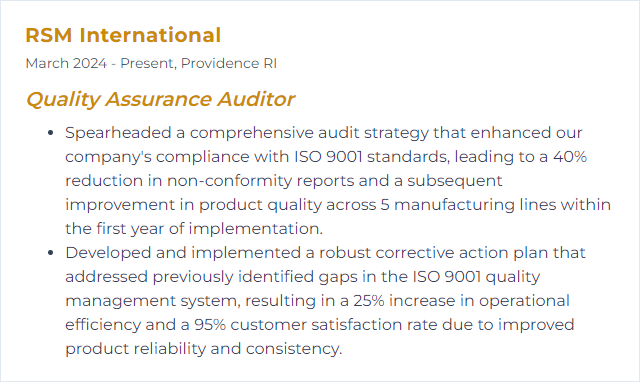
2. Six Sigma
Six Sigma is a data-first method to drive down defects and variation. It leans on structured problem solving (DMAIC) and statistical tools to make processes steady, predictable, and efficient.
Why It's Important
It turns vague problems into measurable gaps, then into verified fixes. Less rework, fewer failures, happier customers.
How to Improve Six Sigma Skills
Run DMAIC with rigor: Clear problem statements, tight baselines, verified root causes, and locked-in controls.
Validate your measurements: Use MSA to confirm the data you depend on is trustworthy.
Deepen statistical chops: Capability analysis, hypothesis testing, regression, DOE. Use the right tool for the signal in the noise.
Target business impact: Quantify cost of poor quality, prioritize by value, and tie improvements to P&L.
Standardize control plans: Sustain gains with controls, SPC, visual checks, and clear ownership.
Coach and scale: Mentor green belts, share lessons learned, and replicate what works.
How to Display Six Sigma Skills on Your Resume

3. Lean Manufacturing
Lean cuts waste and boosts flow. The goal: deliver value with less friction, less delay, less variability. For auditors, it’s about seeing the whole system and challenging non–value-added work.
Why It's Important
Waste hides defects and consumes capacity. Lean exposes problems fast so quality rises while cost and lead time fall.
How to Improve Lean Manufacturing Skills
Run Kaizen often: Small, frequent improvements beat rare, giant overhauls.
Map the value stream: Spot queues, handoffs, and bottlenecks. Trim the clutter, shorten the path.
Lock in standard work: Best-known method, documented and trained. Then improve it.
Practice 5S: Clean, organized, visual workplaces reduce error and make issues obvious.
Use Poka‑Yoke: Prevent mistakes rather than catching them later.
Go to the Gemba: See the process in real time. Observe flow, not just reports.
Shorten changeovers: SMED to free capacity and enable smaller, higher-quality runs.
How to Display Lean Manufacturing Skills on Your Resume

4. SAP Quality Management
SAP Quality Management (QM)—in SAP ERP and S/4HANA—supports quality planning, inspections, notifications, certificates, and analytics. It ties quality into procurement, production, warehousing, and sales so controls are built into the flow of work.
Why It's Important
It centralizes master data, automates checks, and captures evidence. Auditors get traceability, clean histories, and actionable KPIs.
How to Improve SAP Quality Management Skills
Tune configuration: Align catalogs, code groups, MICs, sampling procedures, and usage decisions with how your plant actually runs.
Integrate end to end: Connect QM with MM, PP, EWM/WM, and batch management. Inspections at goods receipt and in-process should be seamless.
Harden master data: Maintain inspection plans, control indicators, and versioning. Bad master data equals bad quality.
Automate workflows: Route quality notifications, escalations, and approvals with clear SLAs.
Use analytics: Build dashboards for defect trends, vendor performance, and process capability. Drive actions, not just reports.
Train roles: Inspectors, planners, and approvers need targeted, scenario-based training and job aids.
Review periodically: Adjust sampling, specs, and triggers as products, vendors, and risks evolve.
How to Display SAP Quality Management Skills on Your Resume
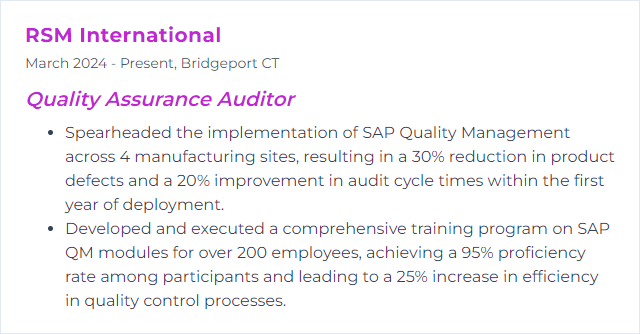
5. Jira
Jira is a work management platform for tracking issues, changes, and projects. In QA, it anchors defect tracking, test coverage, and cross-team collaboration from sprint to release.
Why It's Important
It makes quality visible. Every bug, test, and decision is traceable—who, when, why—so audits move faster and fixes don’t vanish.
How to Improve Jira Skills
Model your process: Tailor issue types, fields, and workflows to mirror your QA lifecycle, including handoffs and approvals.
Master JQL: Build smart filters to surface risks, aging defects, and coverage gaps instantly.
Design dashboards: Real-time views for defect density, reopen rates, lead time, and release readiness.
Automate the tedious: Transitions, assignments, and notifications based on rules. Fewer clicks, fewer misses.
Integrate test management: Connect test cases, executions, and results to requirements and defects.
Harden permissions: Clean roles and schemes protect integrity and keep audits clean.
Standardize definitions: Clear severity/priority scales and acceptance criteria avoid churn.
How to Display Jira Skills on Your Resume

6. Minitab
Minitab is a statistical toolkit built for quality work. It streamlines control charts, capability analysis, regression, DOE, and more—so you can turn data into decisions without wrestling formulas.
Why It's Important
It reveals variation you can’t see by eye, quantifies risk, and validates whether a fix actually fixed anything.
How to Improve Minitab Skills
Strengthen the basics: Sampling, distributions, confidence intervals, and tests. Tools work best on a solid foundation.
Practice the essentials: Create control charts, run capability studies, verify normality, and handle non-normal data correctly.
Verify measurements: Perform Gage R&R and attribute agreement analysis before trusting conclusions.
Explore DOE: Screen factors, optimize settings, and confirm results—fewer trials, better insights.
Standardize templates: Reusable Minitab projects and report formats speed consistency and audits.
Tell the story: Clear graphs and plain-language conclusions beat a wall of p-values.
How to Display Minitab Skills on Your Resume
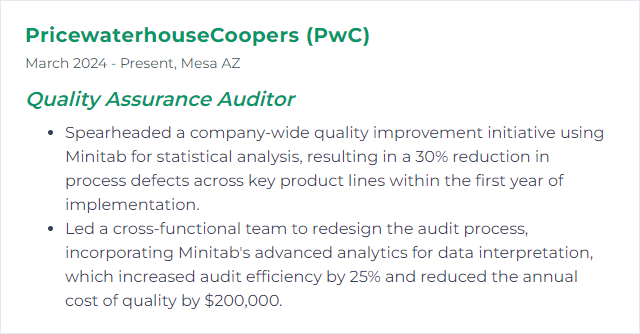
7. Auditing Standards
Auditing standards define how audits are planned, executed, and reported. Think independence, evidence sufficiency, professional judgment, sampling, and documentation that can stand scrutiny. For management systems, ISO 19011 is a common guide.
Why It's Important
Standards prevent guesswork. They anchor consistency and credibility so findings lead to improvement, not arguments.
How to Improve Auditing Standards Skills
Use risk-based plans: Weigh criticality, past performance, and change when setting scope and depth.
Sharpen evidence gathering: Triangulate with interviews, records, and observation. Trace end to end.
Elevate working papers: Clear, complete, cross-referenced notes that anyone can follow later.
Calibrate ratings: Define nonconformity levels and impact consistently across auditors.
Peer review: Periodic file reviews to reduce bias and drift.
Adopt data analytics: Use sampling strategies and simple analytics to target anomalies and trends.
Keep learning: Refresh techniques, sector regs, and ethics annually.
How to Display Auditing Standards Skills on Your Resume
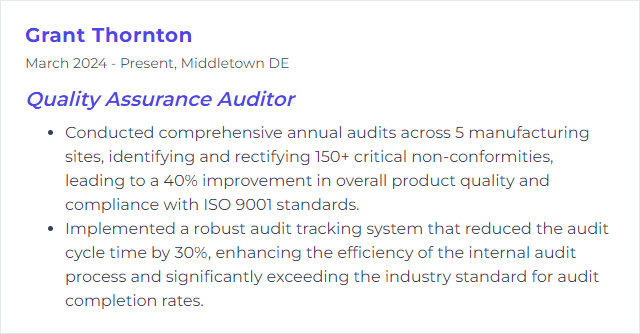
8. Risk Management
Risk management means spotting threats to quality early, sizing them up, and acting before they bite. Identify, analyze, prioritize, respond, and monitor—over and over.
Why It's Important
It protects product integrity, compliance, and customers. Less surprise, more control.
How to Improve Risk Management Skills
Build a risk register: Clear owners, causes, likelihood, impact, and current controls.
Analyze with structure: Use FMEA, fault tree, or bow‑tie methods to understand failure chains.
Prioritize ruthlessly: Treat the big, likely risks first. Park the rest with watch metrics.
Pick the right response: Avoid, reduce, transfer, or accept—with triggers and funding defined.
Track KRIs: Early-warning indicators that tell you when risk is rising.
Review cadence: Refresh risks after changes, incidents, or quarterly at minimum.
Capture lessons: Feed incident learnings back into controls and training.
How to Display Risk Management Skills on Your Resume
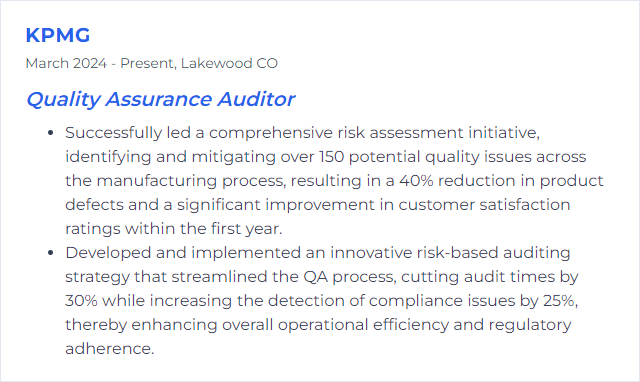
9. CAPA (Corrective and Preventive Action)
CAPA is the engine of continuous improvement. Corrective actions stop recurrence; preventive actions stop occurrence. Both demand real root cause and proof that the fix works.
Why It's Important
Without strong CAPA, the same problems keep coming back wearing a new hat. With it, quality and compliance move in the right direction—and stay there.
How to Improve CAPA (Corrective and Preventive Action) Skills
Write sharp problem statements: Specific, measurable, and time-bound. No fluff.
Do root cause, not blame: 5 Whys, Ishikawa, fault tree—then verify causes with data.
Contain quickly: Protect customers and production while you work the fix.
Targeted actions: Corrective actions remove causes; preventive actions update PFMEAs, procedures, and training.
Effectiveness checks: Define criteria upfront and confirm results after a realistic interval.
Close cleanly: Evidence attached, responsibilities clear, dates met, risks re‑assessed.
Trend CAPA data: Spot repeat issues, long cycle times, and weak verifications.
How to Display CAPA (Corrective and Preventive Action) Skills on Your Resume
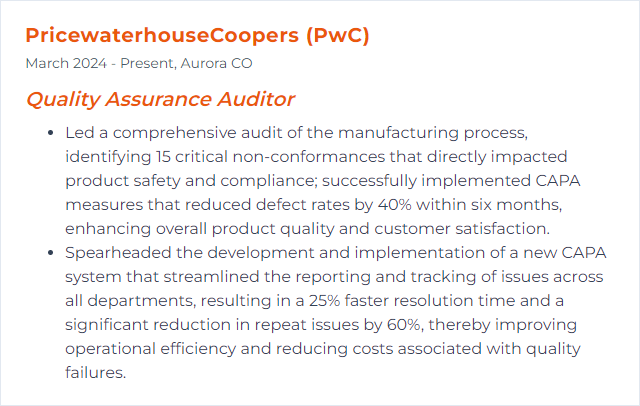
10. GMP (Good Manufacturing Practice)
GMP—often cGMP—ensures products are made and controlled to known standards. It spans facilities, equipment, documentation, data integrity, people, and processes. In life sciences and beyond, it’s non‑negotiable.
Why It's Important
Testing alone can’t catch everything. GMP builds quality into the process so safety and efficacy aren’t left to chance.
How to Improve GMP (Good Manufacturing Practice) Skills
Train continuously: Role-specific, scenario-based training with periodic effectiveness checks.
Lock down documentation: Clear SOPs, revision control, and change control that assesses risk and impact.
Qualify and validate: IQ/OQ/PQ for equipment and processes; validated cleaning and computerized systems.
Protect data integrity: ALCOA+ principles—attributable, legible, contemporaneous, original, accurate, plus the rest.
Strengthen batch records: Complete, accurate, reviewed quickly with robust deviation handling.
Manage suppliers: Qualification, audits, quality agreements, and incoming controls that actually detect risk.
Monitor the environment: EM trending, calibration, maintenance, and controlled utilities.
React and learn: CAPA, complaint handling, recalls, and stability programs that feed improvement.
How to Display GMP (Good Manufacturing Practice) Skills on Your Resume

11. Statistical Analysis
Statistical analysis turns raw data into insight. You measure, test, model, and present so decisions aren’t guesses.
Why It's Important
It quantifies variation and risk, proves or disproves hypotheses, and guides where to intervene for the biggest payoff.
How to Improve Statistical Analysis Skills
Get the fundamentals right: Sampling strategies, distributions, confidence intervals, and power matter.
Use the proper tests: t‑tests, ANOVA, nonparametrics, chi‑square—chosen by design and data type.
Model with intent: Regression and time series to explain and forecast, not to decorate reports.
Check assumptions: Normality, independence, equal variances. If they fail, switch methods.
Focus on interpretation: Practical significance, effect sizes, and confidence intervals beat p‑value hand‑waving.
Visualize smartly: Clean charts that highlight the signal and hide the noise.
How to Display Statistical Analysis Skills on Your Resume
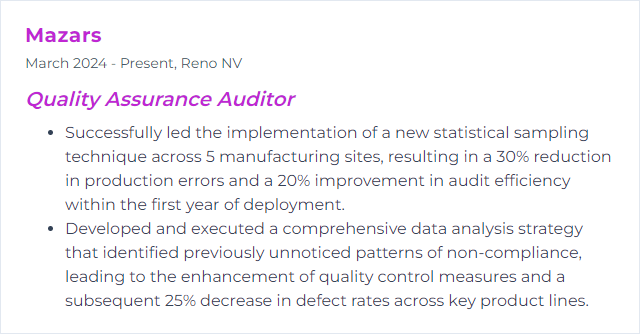
12. Quality Control Tools
Quality Control Tools help you detect defects, analyze causes, and hold the gains. The classics—Pareto, fishbone, control charts, histograms, check sheets, scatter plots, and stratification—still punch above their weight.
Why It's Important
They turn fuzzy problems into structured, solvable ones. Less debate, more clarity, faster fixes.
How to Improve Quality Control Tools Skills
Standardize control plans: Clear inspections, frequencies, and acceptance criteria linked to risks.
Run SPC where it counts: Monitor key characteristics with the right charts and reaction plans.
Use check sheets and Pareto: Capture facts at the source, then rank what matters.
Go deep on root cause: 5 Whys and fishbone—validated by data, not opinions.
Verify measurement systems: Gage R&R and calibration to keep noise out of decisions.
Make it visual: Boards and dashboards that let anyone spot drift in seconds.
Close the loop: Feed findings into CAPA, training, and design updates.
How to Display Quality Control Tools Skills on Your Resume

